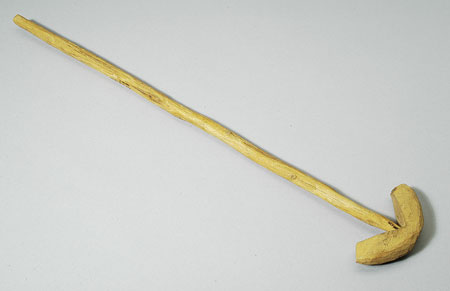Accession Number:
1930.86.39
Country:
Sudan
Region:
[Southern Sudan]
Cultural Group:
Zande
Date Made:
By 1930
Materials:
Wood Plant
Process:
Carved , Perforated
Dimensions:
L = 584, diam shaft = 15.8 by 15; L head = 109, W head = 31.6, th head = 24.5 mm [RTS 17/3/2005].
Weight:
136.3 g
Other Owners:
Probably collected by Evans-Pritchard himself during his fieldwork amongst the Zande, which took place during 1927, part of 1928 and 1929 and for several months during 1930 [CM; RTS 6/7/2004]. Purchased from Edward Evans-Pritchard for the PRM by Henry Bal
Field Collector:
Edward Evan Evans-Pritchard
PRM Source:
Edward Evan Evans-Pritchard
Acquired:
Purchased 31 December 1930
Collected Date:
1927 - 1930
Description:
Wooden stirring stick made in 2 pieces, consisting of a crescentic head piece fitted at right angles onto a narrow handle.
The head has been carved from a single piece of yellowish brown wood (Pantone 7509C), with the upper surface flattened at the centre then sloping away convexly on either side, while tapering to either end.
This surface is covered with clear tool marks, while the end faces and underside have been cut flat.
The head has been pierced through the centre with a small hole, used to mount a handle, carved from a similarly coloured wooden stick with the bark removed and the surface shaved.
The upper end of this has been whittled to fit it into the head, where it lies flush with the upper, working surface.
The handle has split in some areas and there is a minor crack across the stirrer head; otherwise the object is complete and in good condition.
It has a weight of 136.3 grams, and is 584 mm long.
The head is 109 mm long, 31.6 mm wide and 24.5 mm thick, while the oval sectioned shaft has a diameter of 15.8 by 15 mm.
Probably collected by Evans-Pritchard himself during his fieldwork amongst the Zande, which took place during 1927, part of 1928 and 1929 and for several months during 1930. Purchased from Edward Evans-Pritchard for the PRM by Henry Balfour on 31 December 1930, as part of a group of objects, total cost £25.
Evans-Pritchard did not record the local name for this type of object. For a similar Zande food stirrer, see 1930.86.39. Similar objects appear in other Nilotic cultures, including the Moru (1930.86.40 and 1979.20.22), Lotuko (1934.8.58), Dinka (1934.8.16) and Anuak (1936.10.47), although their methods of construction vary. This type of stirrer may be related to those used in Uganda for beating vegetables, found amongst groups such as the Acholi, Lango and Kakwa (see M. Howell & K.P. Wachsmann, 1953, Tribal Crafts of Uganda, p. 164, pl. 39D).
Rachael Sparks 20/08/2005.
Probably collected by Evans-Pritchard himself during his fieldwork amongst the Zande, which took place during 1927, part of 1928 and 1929 and for several months during 1930. Purchased from Edward Evans-Pritchard for the PRM by Henry Balfour on 31 December 1930, as part of a group of objects, total cost £25.
Evans-Pritchard did not record the local name for this type of object. For a similar Zande food stirrer, see 1930.86.39. Similar objects appear in other Nilotic cultures, including the Moru (1930.86.40 and 1979.20.22), Lotuko (1934.8.58), Dinka (1934.8.16) and Anuak (1936.10.47), although their methods of construction vary. This type of stirrer may be related to those used in Uganda for beating vegetables, found amongst groups such as the Acholi, Lango and Kakwa (see M. Howell & K.P. Wachsmann, 1953, Tribal Crafts of Uganda, p. 164, pl. 39D).
Rachael Sparks 20/08/2005.
Primary Documentation:
Accession Book Entry
[BIV, p.
138] - 1930 [insert] 86 [end insert]
E.E.
EVANS PRITCHARD
31 Dec.
Specimens collected by himself in the EASTERN SUDAN, etc.
[...] [p.
139, insert] 38-39 [end insert] - [1 of] 2 T-shaped swizzle sticks, AZANDE.
[...] [Base of p.
139, total of items 1930.86.1-65] - P[ai]d by cheque 31 Dec £
25-0-0
.
Added Accession Book Entry [page opposite 138] - 1930.86 See Related Documents File for letter from Henry Balfour to Evans-Pritchard concerning the purchase of this collection.
Card Catalogue Entry - There is no further information on the catalogue card [RTS 10/2/2004].
Related Documents File - This contains a letter from Balfour to Evans-Pritchard, dated 31 December 1930 that specifies the objects which he would like to purchase for the Pitt Rivers Museum, and suggests a price of £25, which was one quarter of his annual budget. The list matches the objects ultimately accessioned quite closely. 1930.86.39 appears on the list as one of "3 swizzle-sticks (Zande)" [RTS 17/5/2004].
Pitt Rivers Museum label - AFRICA, SUDAN. Zande tribe. Wooden food stirrer. Purchased from E.E. Evans-Pritchard on 31st December 1930, 1930.86.39 [plastic coated label, tied to object; RTS 17/3/2005]
Written on object - Zande [pencil]; swizzle-stick. AZANDE. BAHR-EL-GHAZAL, E. CENT. AFRICA. Evans-Pritchard coll. Pur. 31.12.1930 [black ink; RTS 17/3/2005].
Added Accession Book Entry [page opposite 138] - 1930.86 See Related Documents File for letter from Henry Balfour to Evans-Pritchard concerning the purchase of this collection.
Card Catalogue Entry - There is no further information on the catalogue card [RTS 10/2/2004].
Related Documents File - This contains a letter from Balfour to Evans-Pritchard, dated 31 December 1930 that specifies the objects which he would like to purchase for the Pitt Rivers Museum, and suggests a price of £25, which was one quarter of his annual budget. The list matches the objects ultimately accessioned quite closely. 1930.86.39 appears on the list as one of "3 swizzle-sticks (Zande)" [RTS 17/5/2004].
Pitt Rivers Museum label - AFRICA, SUDAN. Zande tribe. Wooden food stirrer. Purchased from E.E. Evans-Pritchard on 31st December 1930, 1930.86.39 [plastic coated label, tied to object; RTS 17/3/2005]
Written on object - Zande [pencil]; swizzle-stick. AZANDE. BAHR-EL-GHAZAL, E. CENT. AFRICA. Evans-Pritchard coll. Pur. 31.12.1930 [black ink; RTS 17/3/2005].





